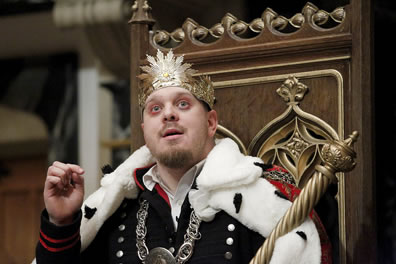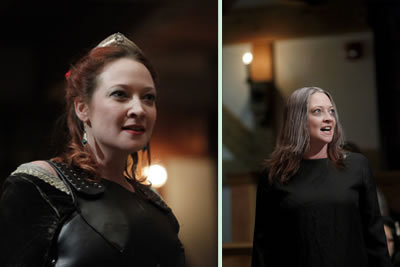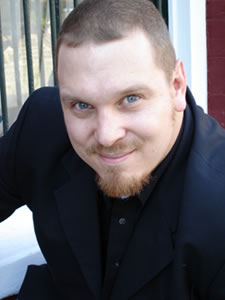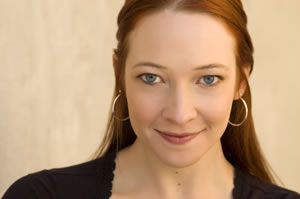A Conversation with King Richard III and Queen Margaret
Four Years, Two Immortal Enemies
By Eric Minton

Benjamin Curns takes the throne as Richard III in the American Shakespeare Center's production of Richard III at the Blackfriars Playhouse. For both actor and character, this was the ultimate turning point in the Richard of Gloucester's three-play journey. Photo by Tommy Thompson, American Shakespeare Center.
In 2009, the American Shakespeare Center at the Blackfriars Playhouse in Staunton, Va., staged Henry VI, Part One, with Benjamin Curns playing Humphrey, Duke of Gloucester. The following year, he reprised the role in Henry VI, Part Two, and after his character's death in III.2, Curns returned to the stage as another character destined to become the next Duke of Gloucester: Richard, the "crookbacked" third son of the Duke of York.
At the end of that play, he memorably killed the Duke of Somerset (Bob Jones) by impaling him with his sword and flipping him high overhead and to the ground. It was a shocking—but, yes, exciting—portent of what was in store for Curns and his Richard. The next year, 2011, Richard would lead his elder brothers, Edward and George, and the House of York to temporary victory in Henry VI, Part Three, and in 2012 he became king—Shakespeare's most notorious—in Richard III.
Curns' two turns as Gloucesters have more in common than the dukedom: both Gloucesters have deep enmity with Queen Margaret, Henry VI's wife. She was played in all four parts of the tetralogy by Sarah Fallon, who, as an actress, has made something of a career of disliking Gloucesters; in addition to Margaret, she has played Regan in King Lear who helps gouge out Gloucester's eyes, and Leicester, a mortal enemy of the Duke of Gloucester, in Look about You, an anonymous play written in Elizabethan times. "We're in this play [Look about You] that we didn't even know before day one and I'm like, 'Oh, right, I hate Gloucester. I've got that,'” Fallon says.
Such is their relationship—Richard with Margaret, Curns with Fallon—that Curns spit a mouthful of wine in Fallon's face during their first scene together in Richard III to the shock of both the audience and their fellow actors who didn't know it was coming. "I think they're a lot alike in a lot of ways," Fallon says of Margaret and Richard. "They would probably not like to say that. Sarah and Ben don't like to say that. They really are a lot alike. Margaret's just at a different point in her journey than Richard is. "
"I will begrudgingly agree," Curns says.

Sarah Fallon as the "she-wolf" Queen Margaret in Henry VI, Part Three (left), and as the desolute Queen Magaret in Richard III (right) in successive Actors' Renaissance Seasons at the Blackfriars Playhouse. Photos by Tommy Thompson, American Shakespeare Center.
After accomplishing the rare feat of playing Margaret in three successive parts of Henry VI over three successive years, Fallon returned to play the part one more time in Richard III. Margaret is, quite simply, Shakespeare's most remarkable character in volume alone if not in stature. These actors who have experienced Margaret firsthand feel Lady Macbeth has nothing on Henry VI's queen as a formidable female. Margaret and Falstaff are the only characters to appear in four plays (a version of Falstaff appears in Henry VI, Part One; he remains offstage in Henry V). But consider this irony: At the end of Henry IV, Part Two, Shakespeare promises to bring Falstaff back for Henry V, but doesn't; he makes no such promise for Margaret at the end of Henry VI, Part Three, but does bring her back, unhistorically, in Richard III. My pet theory is that Shakespeare felt compelled, for commercial reasons as much as artistic, to give Margaret at least a cameo appearance.
As a result, Margaret is not only the one character who appears in all four parts of the tetralogy, she is the only person who appears in Part One who has not died by the end of part four. "I feel very proud, and I think it's very fitting that Margaret is the only one to be in every single part of this tetralogy and still alive at the end of it," Fallon says. "And Richard should have been killed off in Part Two."
Of course, history has seen the role of Richard III eclipse Margaret's stature on the stage—perhaps as early as the original production when Richard Burbage played him. The line of great actors who have portrayed him since run through David Garrick, Edmund Kean, John Barrymore, Laurence Olivier, Antony Sher, and Ian McKellen. One week after I saw Curns' Richard III at the Blackfriars Playhouse I saw Kevin Spacey play the role at BAM in New York. However, Curns did something few if any of those other Richards have done—a feat, perhaps, shared only with the original, Burbage: he played the character in all three plays in which he appears, starting with Henry VI, Part Two, in separate, nonconflated productions over succeeding years using an original practice production process.
He thus brought to his portrayal in Richard III a deep understanding of the Shakespeare-created king who grew up as the runt of his family in a land torn by internecine warfare. "I think all of these parts are enhanced by having done it in the prequels," Curns says of not only Richard but also of such characters as Elizabeth, Hastings, Clarence, and, of course, Margaret who make key contributions to Richard III.
His Richard wasn't so much a villain as a product of the story as written by Shakespeare, and Curns' portrayal added poignant value to the actual title of the play: The Tragedy of Richard III, meaning he is the tragic hero not merely a villain. "My opinion on Richard is that once his father and brother are murdered and tortured there's like a mental snap that happens," Curns says of Richard's experience in Henry VI, Part Three. "And he just says, 'What I have been taught is not true. There is no chivalry, there's only brutality, take the gloves off, do whatever you have to do to get what you want, because there are no rules. Your father tried to follow the rules, look where it got him. Margaret isn't going to play by any kind of rules, so just go. Just go.'" Richard's attitude then adapts to his own family, too, Curns says. "In the end it's like, 'I don't care about your title, where is your real strength?'”
Curns also discovered a clear backstory provided by Shakespeare running through the two pre-Richard III plays that define Richard's drive. While his mother despises him, his father shows him unfettered love and devotion. From his first appearance, Richard seeks to bolster his father, starting with not only killing his father's chief enemy, Somerset, but in the butchery of the killing.
"Shakespeare is always smarter than you think," Curns says. "Even when you think that he's smart, he's smarter than you think. Like, when we were doing Henry VI Two, I just thought it was cool that I got to be in a fight, that you got to see him fight. But having done Part Three, I was like oh, no, no, no, that's really significant who he sought out on the battlefield. I have this image of Richard just sort of looking around for the colors of Somerset saying, 'The only one I want to fight with is my father's worst enemy.'"
Richard does earn his father's love, but it's Richard's advice that ultimately leads to York's death, a fact Curns believes would eat at Richard. Furthermore, upon his father's death, Richard finds himself an outcast even in his own family: Edward and Clarence are the good-looking ones with the power, and Edward chooses Hastings as his tomcatting companion. All of that manifests in Richard's pathological drive for the crown, the seed of which is clearly planted in Henry VI, Part Three, and then revealed in his opening "winter of our discontent" soliloquy of Richard III. But Richard ultimately reveals his true self in his final soliloquy of the tetralogy, the speech that follows the ghosts visiting him on the eve of Bosworth, Curns says.
A "profoundly unhappy person," Curns calls him, Richard "has convinced himself that if he can be king he will be well liked and well loved by many people, and people will feel good about him, and by proxy he will finally feel good about himself." Shakespeare, though, shows the opposite to happen; it is upon achieving the crown that Richard's world begins to fall apart.
 The Blackfriars Playhouse is the only replica reconstruction of Shakespeare's indoor theater, the Blackfriars, and the company uses the conditions that Shakespeare's company would have worked in: universal lighting and the audience on all sides and on the stage (sitting on "gallant stools"). Furthermore, Curns, Fallon, and company staged these plays using the original Elizabethan theater process as part of the ASC's annual Actors' Renaissance Season ("Ren Season" for short), running from January through March. The 12 actors, using only cue scripts and with no director or designers, mount five plays with between 20 and 50 hours of rehearsal time for each production (the season's first plays get the least amount of time to mount, as was the case with Richard III). The actors costume themselves from the theater's stock or their own closets, and they also must come up with their own props and prosthetics. An actress in the company, Allison Glenzer (she played Elizabeth in Henry VI, Part Three and Richard III) created Curns' "cursed" arm that he shows the council after he has consulted privately with Buckingham (played by René Thornton Jr.).
The Blackfriars Playhouse is the only replica reconstruction of Shakespeare's indoor theater, the Blackfriars, and the company uses the conditions that Shakespeare's company would have worked in: universal lighting and the audience on all sides and on the stage (sitting on "gallant stools"). Furthermore, Curns, Fallon, and company staged these plays using the original Elizabethan theater process as part of the ASC's annual Actors' Renaissance Season ("Ren Season" for short), running from January through March. The 12 actors, using only cue scripts and with no director or designers, mount five plays with between 20 and 50 hours of rehearsal time for each production (the season's first plays get the least amount of time to mount, as was the case with Richard III). The actors costume themselves from the theater's stock or their own closets, and they also must come up with their own props and prosthetics. An actress in the company, Allison Glenzer (she played Elizabeth in Henry VI, Part Three and Richard III) created Curns' "cursed" arm that he shows the council after he has consulted privately with Buckingham (played by René Thornton Jr.).
 Because of the troupe size, actors double, triple, even quadruple roles, which is why Curns played both unrelated Gloucesters in Henry VI, Part Two. Similarly, in Richard III, in addition to Margaret, Sarah Fallon played Edward, the Prince of Wales, with Brandi Rhome as his brother, young Richard, Duke of York. The actors work together on blocking and interactions, but they generally come up with their own character interpretations. Fallon decided on her own to come on stage as a chubby Edward eating cherry Twizzlers; John Harrell playing Tyrell then decided that, after murdering the two young princes, he would make his first entry eating Edward's Twizzlers.
Because of the troupe size, actors double, triple, even quadruple roles, which is why Curns played both unrelated Gloucesters in Henry VI, Part Two. Similarly, in Richard III, in addition to Margaret, Sarah Fallon played Edward, the Prince of Wales, with Brandi Rhome as his brother, young Richard, Duke of York. The actors work together on blocking and interactions, but they generally come up with their own character interpretations. Fallon decided on her own to come on stage as a chubby Edward eating cherry Twizzlers; John Harrell playing Tyrell then decided that, after murdering the two young princes, he would make his first entry eating Edward's Twizzlers.
Rhome, meanwhile, had come up with young York's attitude toward his uncle Richard well before she and Curns first worked on the scene together; when young York is supposed to hand a dagger back to Richard, Rhome placed it on the ground and kicked it to him instead, forcing Curns to bend over, bad back and all, to retrieve it. "It was just, 'I'm going to do this,'" Curns says, "and I'm going, 'Don't you ever do anything other than that. I hate you more than anything for doing it, don't ever stop.' Brilliant."
As Richard III was nearing the end of its run, two journeys were coming to a close: Fallon's Margaret and Curns' Richard. I had interviewed Fallon during the run of Henry VI, Part Three in 2011. Her being cast to play Margaret in Richard III merited a follow-up interview. However, because I was so taken with the depth of Curns' portrayal of Richard (I would subsequently rank it as my number one Shakespeareance of 2012), I invited him to join in the interview, too. On the morning of March 26, 2012, when they had only a couple more performances of Richard III remaining, I sat down with both actors together in the lounge of the Stonewall Jackson Hotel in Staunton for an interview that ended up being a roundtable discussion with four people: Fallon, Curns, Queen Margaret, and King Richard III. My review of Richard III, which had already been posted on Shakespeareances.com, included this passage: "Such was [Margaret's] venom and effect on Richard that he resorted to spitting a mouthful of wine in her face, resulting in an audible audience gasp that was three plays over three years in the making." We start our interview with that.
April 4, 2013
[To read the full interview, click here] [For a PDF of this interview, click here]



 Find additional Shakespeareances
Find additional Shakespeareances